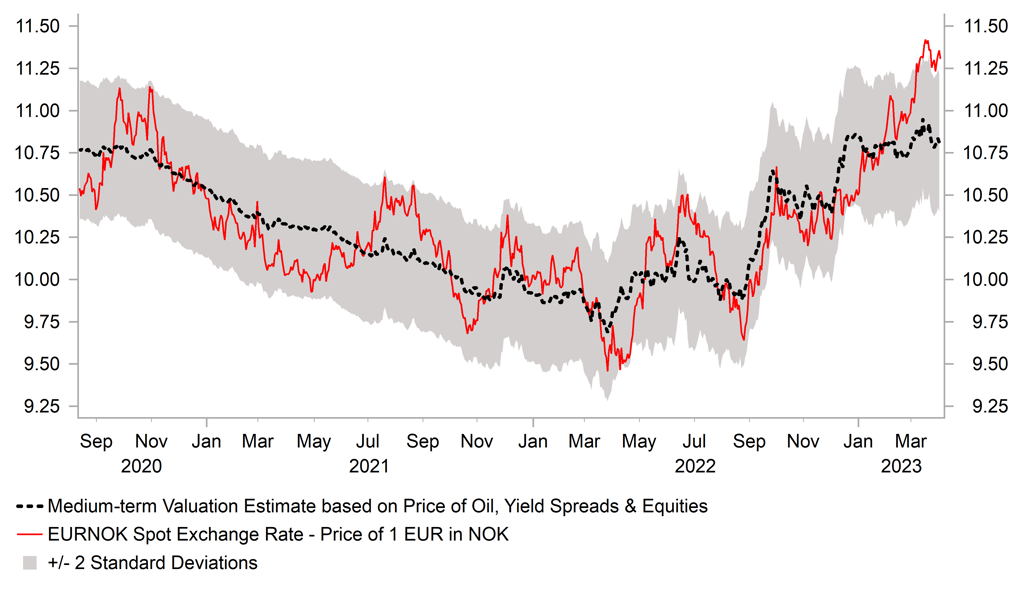USD stages rebound after last month’s sell-off
USD: Fed policy outlook remains tightly linked to banking fears
The US dollar has strengthened overnight resulting in the dollar index climbing back above the 103.00-level as it moves away from last week’s intra-day low of 101.92. The emergence of fears over the health of US regional banks weighed down on the US dollar in March although have not yet proved sufficient to drag the US dollar down to fresh year to date lows. The year to date low from 2nd February at 100.82 remains intact. As we highlighted at the end of last week (click here), fears over the health of US regional banks will have been eased by the release of latest balance sheet data that revealed a reduction in the usage of liquidity windows to support banks. So far it has provided only limited relief for US regional banks’ share prices but could be one factor that is helping to ease downside risks for the US dollar in the near-term. The S&P regional banks equity index remained close to year to date lows on Friday, and around 40% below the year to date peak from in early February. Similarly, there has not yet been a significant repricing in the US rate market that is continuing to price in more dovish outlook for Fed policy. The US rate market is pricing around 16bps of
further Fed hikes, and then followed by around 38bps of cuts by the end of this year. It highlights that market participants remain of the view that recent disruption in US regional banks will result in a significant tightening in credit conditions over the next six to twelve months that will trigger sharper slowdown in growth. In effect the tightening in credit conditions will do the Fed’s job so that they no longer have to raise rates much further to make them more confident that inflation will fall back to their target.
Those expectations were supported as well at the margin by the release of the latest US PCE deflator report on Friday that revealed softer than expected inflation. The core PCE deflator measure slowed to 0.3% in February following a downwardly revised 0.5% increase in January although the underlying trend remains uncomfortably strong for the Fed. Inflation over the last six months and over the last year has been running at around 4.5% which compares to the pre-COVID shock rate from the start of 2020 at around 1.7%. The next challenges for the recent dovish repricing of Fed rate hike expectations will be provided by the release of the ISM manufacturing survey (today), ISM services survey (Wednesday), and non-farm payrolls report (Friday). It is likely too soon to see the negative impact of the US regional banking sector fallout in the US economic data at the current juncture posing some upside risk for the US dollar in the week ahead.
NOK HAS UNDERPERFORMED SIGNIFICANTLY AT START OF THIS YEAR

Source: Macrobond & MUFG GMR
Oil FX: Will OPEC+ production cut provide catalyst for NOK rebound?
One of the main macro developments over the weekend has been the surprise decision by OPEC+ to reduce oil production by more than 1 million barrels/day. The initial impact of the cuts starting from next month will add up to about 1.1 million barrels/day, and then from July due to the extension of Russia’s existing supply reduction, there will be about 1.6 million/day less on the market than previously expected according to Bloomberg. The production cuts were described as a “precautionary measure aimed at supporting the stability of the oil market”. The decision was announced the day before OPEC+ was due to meet today. The actual reduction in supply though maybe smaller than around 1.6 million barrels/day as most OPEC+ members are already producing significantly below their present quotas. The decision should though provide more support for the price of oil that had continued to fall at the start of this year. The price of Brent hit a fresh year to date of low of 70.12/barrel on 20th March triggered by an intensification of global banking sector fears. OPEC+’s decision to cut production has resulted the price of Brent reversing most of last month’s losses and brings it back more into line with the average over the previous three months.
The higher price of oil should help to provide more support oil-related G10 currencies such as Canadian dollar and Norwegian krone. The Norwegian krone has been hit particularly hard this year and is by some distance the worst performing G10 currency (-6.5% vs USD YTD & -7.2% vs. EUR YTD). According to our short-term valuation model that takes into account the price of oil, yields spreads and equity performance, the krone became significantly undervalued in March. The OPEC+ announcement could provide the catalyst needed to trigger a correction higher for the krone.
KEY RELEASES AND EVENTS
|
Country |
GMT |
Indicator/Event |
Period |
Consensus |
Previous |
Mkt Moving |
|
EC |
09:00 |
S&P Global Eurozone Manufacturing PMI |
Mar F |
47.1 |
47.1 |
!! |
|
UK |
09:30 |
S&P Global/CIPS UK Manufacturing PMI |
Mar F |
48.0 |
48.0 |
!! |
|
US |
15:00 |
Construction Spending MoM |
Feb |
0.0% |
-0.1% |
!! |
|
US |
15:00 |
ISM Manufacturing |
Mar |
47.5 |
47.7 |
!! |
Source: Bloomberg

